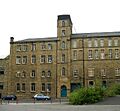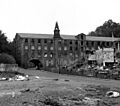List of mills in Huddersfield facts for kids
Huddersfield, a town in West Yorkshire, England, was once a very important place for making textiles, especially wool and cotton. For hundreds of years, people in this area have been skilled at turning raw wool into cloth. During the Industrial Revolution, many large factories called textile mills were built here. These mills used machines powered by steam or water to spin yarn and weave fabric much faster than people could by hand.
These mills were a huge part of Huddersfield's history and economy. They provided jobs for thousands of people and helped the town grow into a busy industrial center. Many of these old mill buildings still stand today, reminding us of a time when Huddersfield was at the heart of the world's textile industry.
Contents
What are Textile Mills?
A textile mill is a factory where raw materials like wool or cotton are processed to make yarn and fabric. Before mills, most textiles were made by hand in homes. This was a slow process. The invention of new machines, like the spinning jenny and power loom, changed everything.
How Mills Changed Things
These new machines were too big and expensive for homes. So, large buildings were constructed to house them. These were the first textile mills. They were often built near rivers for water power, or later, near coal mines for steam power. Huddersfield had both, making it a perfect spot for mills.
The Work Inside a Mill
Inside a mill, there were many different jobs. Some people cleaned and prepared the raw wool or cotton. Others operated spinning machines that twisted fibers into long threads called yarn. Then, weavers used looms to interlace these yarns into fabric. There were also jobs for dyeing the fabric different colors and finishing it. It was often noisy and busy work, but it was important for making clothes and other goods for people all over the world.
Mills in Golcar
Golcar is a village near Huddersfield that had many textile mills. The Colne Valley area, where Golcar is located, was perfect for mills because of its rivers and streams that could power the early machines.
Examples of Golcar Mills
- Albion Mills: Built in 1865, this mill was a busy place where wool was processed.
- Commercial Mill: This mill, built in 1861, is so important that part of it is now a Grade II listed building. This means it's protected because of its special history and architecture.
- Heath House Mill: This mill was known for its textile production.
- Holme Mill: Another significant mill in Golcar, contributing to the area's textile output.
- Lees Mill: This mill played a role in the local economy.
- Low West Wood Mills: By 1881, this mill was operated by Beaumont, Bates & Sons.
- New Mill (Parkwood Mills): This was a large mill complex in Golcar.
- Spa Mills: An important mill in the Colne Valley.
Mills in Huddersfield Town
The town of Huddersfield itself was home to a huge number of mills. Many of these were located along the River Colne and River Holme, which provided the water needed for textile processing and power.
Key Huddersfield Mills
- Albany Mills: Also known as Gladstone Mill, it was built in 1868 and by 1910, it had 15,000 spindles for spinning yarn.
- Colne Bridge Mill: Located in Colne Bridge, this mill started around 1792. By 1910, it was a massive operation with over 76,000 spindles!
- Firth Street Mills: Built in 1866, this mill is now part of Huddersfield University. It's also a Grade II listed building.
- Folly Hall Mills: This mill, built in 1832 by Joseph Kaye, is an even more important historical building, listed as Grade II* listed building.
- Larchfield Mills: Also built in 1866 and now part of Huddersfield University, it's another Grade II listed building.
- Priestroyd Mills: This mill, built in 1835, is a Grade II listed building and was home to several textile companies.
- Starkey's Mill: Built in 1819, parts of this mill are also Grade II listed building.
- Turnbridge Mill: This mill was built in 1845.
- Zetland Mills: Built in 1854, this mill is also a Grade II listed building.
Mills in Lockwood
Lockwood, a part of Huddersfield, also had its share of important textile mills. These mills were crucial for the local economy and provided many jobs.
Notable Lockwood Mills
- Albert Mills: Built in 1854, this mill is a Grade II listed building.
- Bath Mills: Operating around 1850, by 1910, it had 8,400 spindles.
- Britannia Mills: Also known as Firths Mill, this mill was built in 1861 and is a Grade II listed building.
- Broadfield Mills: Built in 1843, this mill was later demolished.
- Crosland Moor Mill: This mill was an important part of Lockwood's textile industry.
Mills in Longwood
Longwood, another area within the Colne Valley near Huddersfield, also played a significant role in the textile industry.
Longwood Mill Examples
- Sunny Bank Mills: This mill was a major woollen mill in Longwood.
- Woodland Mills: Another important textile mill in the Longwood area.
The Legacy of Huddersfield's Mills
Today, many of these old mill buildings have found new life. Some have been turned into apartments, offices, or even parts of the university. They stand as a testament to Huddersfield's rich industrial past and the hard work of the people who built and worked in them. They remind us how important the textile industry was to this region and how it shaped the towns and cities we see today.
Images for kids
See also
- Heavy Woollen District
- Textile processing

















